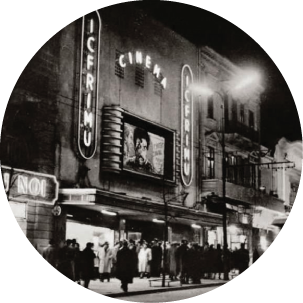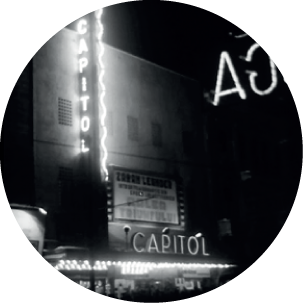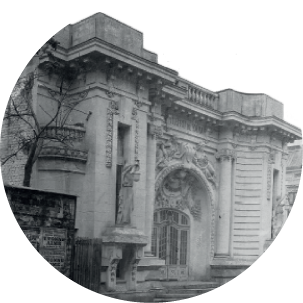1990
The ensemble is now owned by the Ministry of Culture, which administers it through RADEF. The cinema and summer garden close and are removed from the public circuit.
1977-1989
A series of interventions and modifications takes place arbitrarily for both the Cinema and Summer Theatre:
The Summer Theatre on Constantin Mille street
- the statues from the façade are removed, as well as a part of the decorations;
- the entrance is re-organized and the covered stairs are eliminated to make room for a restroom;
- the entrance door is replaced;
- an intermediary level is added for the new projection room;
- the two metallic outdoor stairs are installed leading up to the balcony, right through the garden seats, replacing the indoor stairs.
The Cinema from Elisabeta boulevard
the basement and the restrooms are shared with Festival Cinema.
1977
The earthquake affects the ensemble and it sustains some serious damage at the structure level but also involving the rooftop.

1947-1948
During the forced nationalization, Capitol Cinema and Alhambra Summer Theatre become state property, through the Minister of Arts and Information. Afterward, Alhambra Summer Theatre becomes Capitol Garden with the address Constantin Mille street, ex-Sărindar. Capitol Cinema is renamed I.C. Frimu Cinema and loses, alongside its identity, the light signal. Elisabeta boulevard is renamed 6th of March boulevard, known as 06.03.

1938
CAPITOL Cinema, its entrance and foyer are radically transformed through the intervention by the architect Henrieta Delavrancea Gibory, in the Bauhaus modernist style.
The “inauguration” of Clasic Cinema takes place with the Romanian film in 5 acts, “Țigăncușa dela iatac”. The inauguration probably refers to the changing of the owner (do. Dobrovici -> I. Gabor) or the resuming of the projections schedule, after the pause caused by World War I. The text added in pen states that the inauguration took place in the presence of the King and Queen of Romania.
For a good period of time, you could access the cinema hall through the ground floor of the house from Elisabeta, no. 14.
1917-1923
Because of the uncertain situation of that period, we can assume that both the inauguration of Clasic Cinema and the Alhambra Summer Theatre took place after the end of World War I.

1916
Architect Nicolae Nenciulescu develops the plans for Alhambra Summer Theatre, and construction starts on Sărindar street.
Written on the plans, one can notice the name of the owner, Dumitru Papaianopol. On the West side, the neighbors are Bragadiru, on the East side is the property of mister G.G. Arion. On the South side of the allotment is mentioned doctor Dobrovici and we can assume that at that moment, the Clasic Cinema hall wasn’t built yet.
1915
The transformation plans for doctor Dobrovici’s house into a cinema are approved. The building becomes a foyer and an entry apparatus while a new cinema hall is added. Originally, Capitol was named Clasic Cinema and the address was Elisabeta 14. Even though the plans are approved by the chief architect of the city, the architect of cinema is not known. We notice the note and intention “to build” in the north of the allotment, where a year later Alhambra Summer Theatre appears.
1913
The first premiere that was discovered during the historical study was “Culesul viilor” (The harvesting of vineyards), an advertising film shown on 3 January 1913. It tells the story of wine production in Valea Călugărească.
The film production company “Leon Popescu” Art Film (the owner of “Leon Popescu” theatre, ex-Liric) launched with a premiere at Clasic Cinema, on 11 June 1913 – “Amorurile unei prințese” (A princesses’ romances”, directed by Marioara Voiculescu. Some sources report a second Clasic Cinema, in the Moșilor area.

1912
The Rampa newspaper announces the opening of Clasic Cinema that takes places Saturday, 26 May: “An event in the Bucharest nightlife: the new and big Clasic Cinema, a wonderful place built for this purpose on the Elisabeta Boulevard at no. 10 (according to some sources at no. 14), across the road from Radivon, opens its gates on Saturday. Two young artists: Nicolae Grigorescu from the National Theatre and Manescu, an important sculptor, they began to build a big theatre-cinema under the name of Clasic Cinema. It is a superb, tall, hygienic, with a row of balconies and over 1.000 seats. It is wonderfully decorated.”

You must be logged in to post a comment.